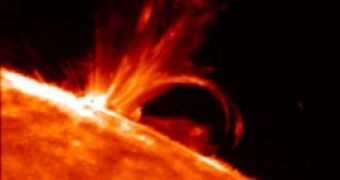Imagine being on a boat, or in a car, in an unfamiliar place, and you're relying on your GPS system to guide you through. Suddenly, it goes blank, and you're lost, because you had the misfortune of not bringing along maps, a compass or a sextant, which you probably wouldn't know how to use, anyway.
GPS receivers have become widely used in recent years, using satellite signals in navigating airplanes, ships and automobiles, and in using cell phones, mining, surveying and even transferring money, but even the most expensive piece of technology can't function in case of a massive solar flare.
Indeed, banks use the system to synchronize money transfers, "so space weather can affect all of us, right down to our wallet," said Anthea J. Coster, an atmospheric scientist at the Haystack Observatory of the Massachusetts Institute of Technology, MIT.
"Our increasingly technologically dependent society is becoming increasingly vulnerable to space weather," David L. Johnson, director of the National Weather Service.
A solar eruption in December disrupted the Global Positioning System, creating radio bursts that traveled to Earth, covering a broad frequency range. In addition to the GPS system, the December solar flare affected satellites and induced unexpected currents in the electrical grid.
"Measurements with NJIT's solar radiotelescope confirmed, at its peak, the burst produced 20,000 times more radio emission than the entire rest of the Sun. This was enough to swamp GPS receivers over the entire sunlit side of Earth."
Solar flares have been known to knock out satellites and even electricity grids, but the researchers told the Space Weather Enterprise Forum this was an unexpectedly serious new effect.
"In December, we found the effect on GPS receivers were more profound and widespread than we expected," said Paul Kintner, a professor of electrical and computer engineering at Cornell University in New York. "Now we are concerned more severe consequences will occur during the next solar maximum"
Solar activity rises and falls in 11-year cycles, with the next peak expected in 2011.
There are two possible ways to shield the system, he said, both very expensive. Either alter all GPS antennas to screen out solar signals or replace all of the GPS satellites with ones that broadcast a stronger signal.
As we don't know how often we can expect solar radio bursts of this size or even larger, it's essential to learn more about the sun's behavior quickly in an effort to find ways to predict such events.

 14 DAY TRIAL //
14 DAY TRIAL //